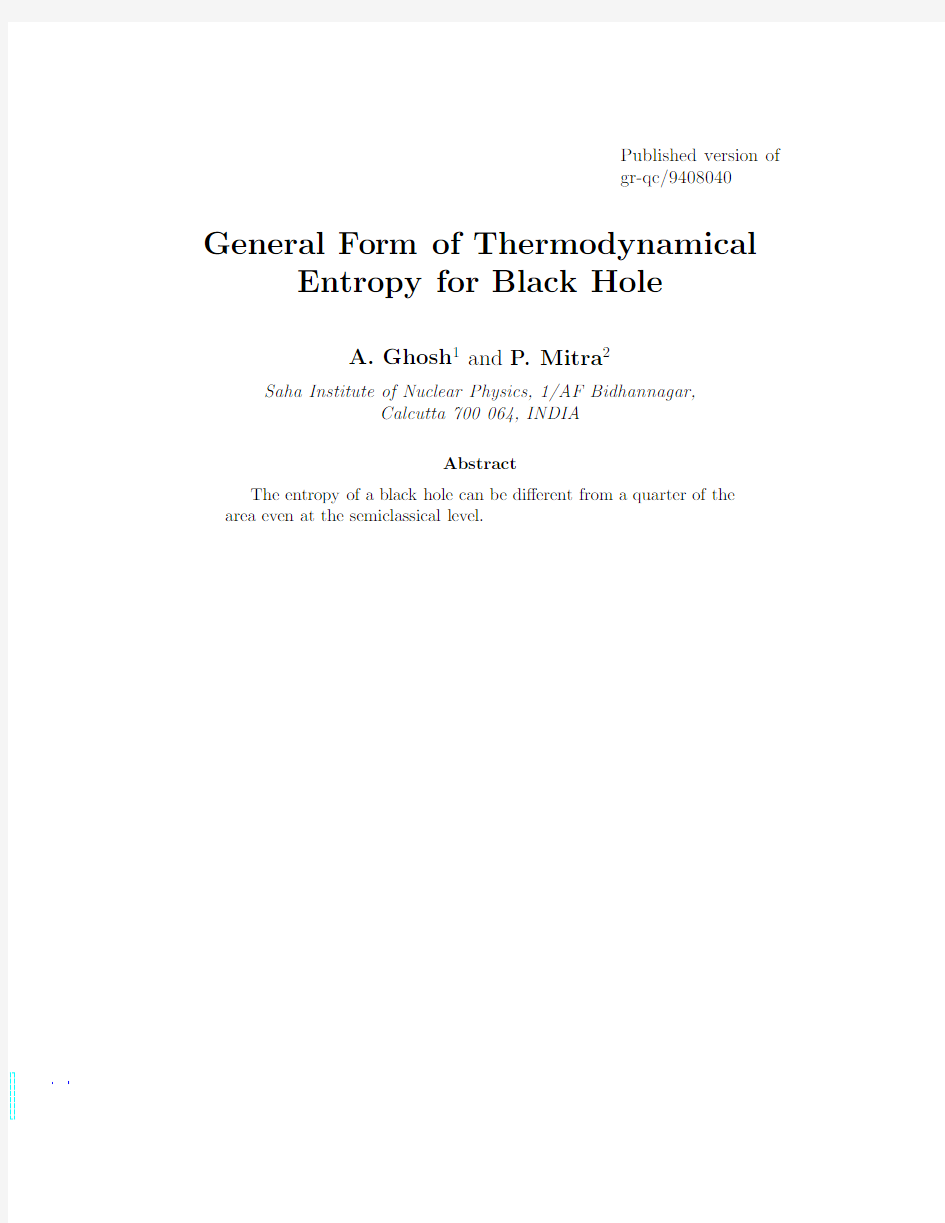General form of thermodynamical entropy for black hole


a r X i v :g r -q c /9408040v 2 17 J u n 1997
Published version of gr-qc/9408040
General Form of Thermodynamical
Entropy for Black Hole
A.Ghosh 1and P.Mitra 2
Saha Institute of Nuclear Physics,1/AF Bidhannagar,
Calcutta 700064,INDIA
Abstract
The entropy of a black hole can be di?erent from a quarter of the area even at the semiclassical level.
It has long been known that black hole physics has a set of laws parallel to the laws of thermodynamics[1].By virtue of this parallelism,the area of the horizon of a black hole was interpreted as its entropy[2].After the dis-covery of Hawking radiation and the development of a semiclassical concept of temperature for black holes,this analogy became more well-de?ned and at present a quarter of the area of the horizon is supposed to be a quantitative measure of the entropy for non-extremal black holes.No conclusive inter-pretation of this expression in terms of a counting of states has as yet been found in spite of serious attempts[3].Reasonable progress has been made in the case of extremal black holes[4],but there the entropy is proportional to the mass of the black hole rather than the area[5].In view of this departure from the area law at the semiclassical level,it is natural to examine the basis for the area formula and to see if deviations from the standard expression for the entropy can be permitted by general principles also for non-extremal black holes.
For the simplest black hole,namely the one discovered by Schwarzschild, the Hawking temperature is given by
1
T=
horizons occurring at
r ±=M ±
M 2
?Q 2.
(3)
The area of the outer horizon is given by
A =4π(r 2
++J 2M ?2)
(4)
and the Hawking temperature by
T =
r +?r ?
?Q
A
=
Qr +
?J
A
=
JM ?1
?Q
S
,
(10)
2
?=?M
4
)=? Φ?ΦT dJ.(12) Since the left hand side is an exact di?erential,one must have
Φ?Φ?Q(13)
and
????J(14) with F(J,Q)undetermined.Consequently
S=
A
T =
1
By using the generalized Smarr formula[7,1]
M=
T A
?J +Q
?F
σ(N??V j)
=?iM
T
(22)
when N,V(see Eq.(3.9a)and Sec.VI of[8])are constant on B.Now
the potential V related to?is not unique and can be modi?ed in the way
?of our paper is replaced by ?.This will introduce in the microcanonical entropy the kind of ambiguity that we have identi?ed above.If a more direct
and fundamental way could be found to introduce a microcanonical partition
function,the ambiguity in the entropy could perhaps be removed.
Our derivation obviously generalizes to the case of more parameters,
where the parameters are kept independent of one another and of the mass
4
i.e.,non-extremal black holes are considered.In short,then,we have demon-strated that such black holes do not have their entropies uniquely determined. The general form of the ambiguity involves undetermined homogeneous func-tions of degree1in the parameters,i.e.,charge,angular momentum and so on.
References
[1]J.Bardeen,B.Carter and S.Hawking,Comm.Math.Phys.31,161
(1973)
[2]J.Bekenstein,Phys.Rev.D7,2333(1973);Phys.Rev.D9,3292(1974)
[3]G.’t Hooft,Nucl.Phys.B256,727(1985);L.Susskind and J.Uglum,
Phys.Rev.D50,2700(1994)
[4]A.Sen,hep-th/9504147
[5]A.Ghosh and P.Mitra,Phys.Lett.B357,295(1995);A.Ghosh and P.
Mitra,hep-th/9509090
[6]G.Gibbons and S.Hawking,Phys.Rev.D15,2752(1977)
[7]L.Smarr,Phys.Rev.Lett.30,71(1973)
[8]J.D.Brown and J.W.York,Phys.Rev.D47,1420(1993)
5
